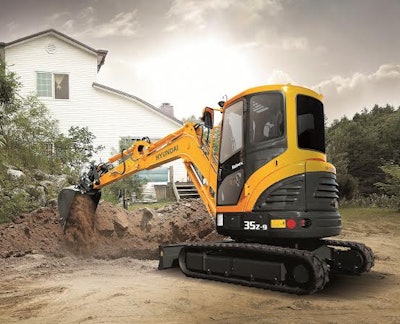
Without the proper maintenance, these machines won’t be as productive on the jobsite and can run up your O&O costs.
Here are 5 compact excavator maintenance issues from Lee Shirey, regional service manager at Hyundai Construction Equipment Americas Inc., landscapers shouldn’t overlook.
1. Track tension. One of the most overlooked service points on compact excavators is track tension. Most all have rubber tracks, which need to be kept properly adjusted to maximize longevity and minimize wear on the track and its components. A track running loose will accelerate wear causing unnecessary downtime and put a stop to production to reinstall a new track. On the other hand, a track running too tight will cause the rubber material to tear and will greatly increase wear on the other track system components, including but not limited to, traction motors, sprockets and front idlers. Operators should always refer to the operator’s manual and check track sag measurement on a regular basis to ensure the track tension is just right.
2. Grease. The lifeblood of all pins and bushings, grease is another common service point often forgotten about. As a general rule of thumb, all pins and bushings should be greased daily. The operator’s manual will help with identifying each grease point and providing recommendations for quantity and grade of grease. If there are multiple operators using a single machine, it might be a good idea to mark less obvious grease points, such as the turntable bearing, with orange marking paint around the grease nipple as a reminder to all users.
As with under-greasing, over-greasing can also be problematic. One to three shots of grease is typically more than enough to do the job. Any extra, and it becomes a waste of money while also presenting an environmental hazard, not to mention causing a considerable mess.
3. Propel drive gearbox. One of the most vital components to a machine’s performance, the propel drive gearbox often gets neglected when it comes to servicing. Many times, gearboxes are covered in mud, with the fill and drain plugs not visible so operators and service personnel rarely notice them. However, gearboxes require an oil change at around 1,000 hour intervals, depending on the manufacturer. Gearboxes may be small, but they are still expensive to manufacture because they have the same internal parts as their larger cousins, just on a smaller scale. Typically holding between a 1/2 to 1 quart of oil, they can be changed pretty quickly in most cases, so it is a small investment that will pay off in the future.
4. Hydraulic oil change. Hydraulic oil can be misleading because although it may look clean, just like engine oil, it breaks down, loses its viscosity and its ability to hold contaminants in suspension, a process that helps protect all moving parts in the system. Hydraulic systems are designed to precise tolerances and most hydraulic failures can be traced back to contaminated hydraulic oil or even the wrong hydraulic oil.
One of the many important functions hydraulic oil performs is that of absorbing moisture in the system and keeping it away from the hydraulic components. You may not think that rust could be a problem in a sealed hydraulic system that is always full of oil, but it is. Don’t make the mistake of thinking that just because hydraulic oil looks good, that it is. By the time hydraulic oil becomes cloudy, it is far beyond the point where it should have been changed and has lost much of its ability to protect the components in your hydraulic system properly. Most equipment manufacturers suggest a hydraulic oil change interval in the 2,000 to 4,000 hour range, but every machine is different. Your operator’s manual will provide you with a specific servicing timetable and oil requirements to follow.

Proper service records are also helpful when working with your dealer if an issue arises. Accurate records will prove to both your dealer and the manufacturer that you care about your equipment and you are servicing the machine as required. This can be crucial when dealing with warranty claims. This principle is necessary if you have an entire fleet of mini-excavators or just a single machine.
So the next time you service the engine oil and fuel filter on your compact excavators, check your operators manual, take a little extra time and money, service your machine properly and always document the service. This is, hands down, the most cost-effective way to ensure minimal downtime in the future. In the long run, you and your bottom line will be glad you did.










